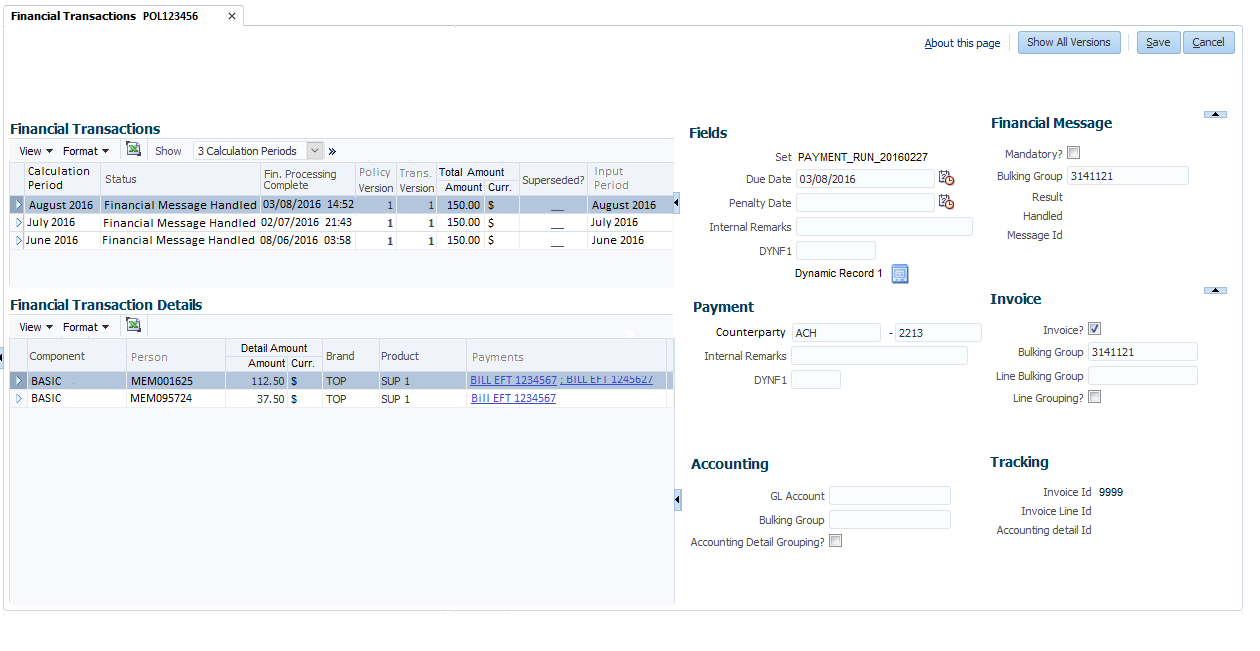Financial Details
This page shows financial transactions and the related financial transaction details for a specific policy or policy version. Some fields are updatable as long as the financial transaction is not handled by the financial message creation process. Note that non-seeded dynamic fields and dynamic records are always updatable.
The page shows only financial transactions that result from premium calculation.
The page has two main sections:
-
Financial Transactions
This section shows the financial transactions created for the policy in context. -
Financial Transaction Details
This section shows the financial transaction details that belong to the financial transaction that is selected in the Financial Transactions section of this page.
Display and Specifics
The following image is a mockup of the view financial details page:

The page is opened with the selected financial transaction and financial transaction details in context. Clicking the button 'Show all versions' shows all financial transaction versions of the policy displayed in the top section of this page.
Displayed Fields to Object Model
Financial Transactions
The financial transactions section is divided into 3 sub-sections:
-
Financial Transactions
This is a multi row display of financial transactions related to the policy. Financial transactions are sorted on calculation period start date, policy version and financial transaction version. Reversal financial transactions are not displayed in this page. -
Fields
This sub-section shows general fields of the financial transaction in context. This section can be extended by dynamic fields and dynamic records attached to the financial transaction. This sub-section becomes scroll-able when to the total number of fields displayed in this section is more than 5. -
Financial Message
This sub-section shows the fields related to the financial message of the financial transaction in context.
width="100%",cols="30,70",options="header",]
Field |
Object.field |
Calculation Period |
BaseFinancialObject.calcPeriodStartDate |
Status |
BaseFinancialObject.status |
Fin. Processing Complete |
BaseFinancialObject.generalFinancialProcessingCompleteDatetime |
Policy Version |
FinancialTransaction.policyVersion |
Trans. Version |
FinancialTransaction.version |
Total Amount |
FinancialTransaction.totalAmount and FinancialTransaction.totalAmountCurr (the currency display code is displayed) |
Superseded? |
FinancialTransaction.FinancialTransactionProcessData.superseded |
Input Period |
FinancialTransaction.inputCalcPeriodStartDate |
Fields |
|
Set |
FinancialTransaction.FinancialTransactionProcessData.FinancialTransactionSet.code |
Due Date [1] |
FinancialTransaction.FinancialTransactionProcessData.dueDate |
Penalty Date [1] |
FinancialTransaction.FinancialTransactionProcessData .penaltyDate |
Internal Remarks [1] |
FinancialTransaction.FinancialTransactionProcessData.internalRemarks |
Dynamic Field 1…. [2] |
FinancialTransaction.<Dynamic Fields> |
Dynamic Records [2] |
|
Financial Message |
|
Mandatory? [1] |
FinancialTransaction.FinancialTransactionProcessData.financialMessageMandatory |
Bulking Group [1] |
FinancialTransaction.FinancialTransactionProcessData.finMessageBulkingGroup |
Result |
FinancialTransaction.FinancialTransactionProcessData.finMessageResult |
Handled |
FinancialTransaction.FinancialTransactionProcessData.finMessageHandledDatetime |
Message Id |
FinancialTransaction.FinancialTransactionProcessData.finMessageId |
Updating the mandatory indicator sets the status of the policy’s base financial object to Changed. This means that the Supersede financial transactions activity must executed (again) for the policy’s base financial object before a financial transaction for this policy can be included in a financial message.
Displaying Dynamic Record Values
It is possible that the financial transaction is extended with dynamic record values. These dynamic records are listed in the Fields section of the page. Each dynamic record entry has a view icon that open a dialog that shows the contents of the dynamic record. These dialogs are display only.
Financial Transaction Details
The financial transaction details section is divided into 5 sub-sections:
-
Financial Transaction Details
This is a multi row display of financial transactions related to the policy. Financial transaction details are sorted first on component display sequence, then on sequence number. -
Payment
This sub-section shows payment related fields of the financial transaction detail in context. This sub-section includes dynamic fields attached to the financial transaction detail. This sub-section becomes scroll-able when to the number of fields displayed in this section is more than 4. -
Invoice
This sub-section shows the invoice related fields of the financial transaction in context. -
Accounting
This sub-section shows the accounting related fields of the financial transaction in context. -
Tracking
This sub-section shows the fields set by the generate financial message process for tracking purposes.
width="100%",cols="30,70",options="header",]
Field |
Object.field |
Component |
FinancialTransactionDetail.componentCode |
Entity |
FinancialTransactionDetail.FinancialTransactionDetailProcessData.insurableEntityCode |
Detail Amount |
FinancialTransactionDetail.amount and FinancialTransactionDetail.amountCurr (the currency display code is displayed |
Brand |
FinancialTransactionDetail.productBrandCode |
Product |
FinancialTransactionDetail.productCode |
Registration |
Registration.Type + ' ' + Registration.Code Type + ' ' + Registration.Code |
Payment |
|
Counterparty [1] |
FinancialTransactionDetail.FinancialTransactionDetailProcessData.counterpartyQualifier |
Internal Remarks [1] |
FinancialTransactionDetail.FinancialTransactionDetailProcessData.internalRemarks |
Dynamic Field 1…. [2] |
FinancialTransactionDetail.<Dynamic Fields> |
Invoice |
|
Invoice? [1] |
FinancialTransactionDetail.FinancialTransactionDetailProcessData.invoice |
Bulking Group [1] |
FinancialTransactionDetail.FinancialTransactionDetailProcessData.invoiceBulkingGroup |
Line Bulking Group [1] |
FinancialTransactionDetail.FinancialTransactionDetailProcessData.invoiceLineBulkingGroup |
Line Grouping? [1] |
FinancialTransactionDetail.FinancialTransactionDetailProcessData.invoiceLineGrouping |
Accounting |
|
GL Account [1] |
FinancialTransactionDetail.FinancialTransactionDetailProcessData.generalLedgerAccount |
Bulking Group [1] |
FinancialTransactionDetail.FinancialTransactionDetailProcessData.accountingBulkingGroup |
Accounting Detail Grouping? [1] |
FinancialTransactionDetail.FinancialTransactionDetailProcessData.accountingDetailGrouping |
Tracking |
|
Invoice Id |
FinancialGroupingCriteria.StampId |
Invoice Line Id |
FinancialGroupingCriteria.StampId |
Accounting detail Id |
FinancialGroupingCriteria.StampId |
Counterparty is displayed as one concatenated field separated by a dash (-).